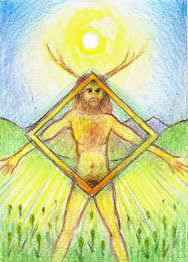|
  ingwaz
(pronounced ING-wahz) represented the sound
of English ng (as
in sing, not finger) in runic
writing. Ing was a Germanic deity, perhaps an
aspect of Freyr, seldom appearing in the stories
that have come down to us, but who gave his name to
several important Germanic tribes along the
continental shores of the North Sea. The
Anglo-Saxon rune poem describes him
thus: ingwaz
(pronounced ING-wahz) represented the sound
of English ng (as
in sing, not finger) in runic
writing. Ing was a Germanic deity, perhaps an
aspect of Freyr, seldom appearing in the stories
that have come down to us, but who gave his name to
several important Germanic tribes along the
continental shores of the North Sea. The
Anglo-Saxon rune poem describes him
thus:
Ing
was first seen by men among the East-Danes,
till, followed by his chariot,
he departed eastwards over the waves.
So the Heardingas named the hero.
Both
as tribal progenitor and as consort to Freya, Ing
or Ingvi-Frey embodies the male generative
principle. He is the primal father, the bringing of
fertility and fecundity. Many ideas and concepts
flow from this core: male sexuality and sexual
energy, fatherhood, agricultural fertility,
creativity, leadership, family, and initiating a
legacy that outlives one's bodily life.
Along
with tiwaz, his is one of only two runes that
unambiguously names a deity. (Ansuz, sowilo, and
berkano can be seen as referring to deities
indirectly, or are merged with other more mundane
meanings.) Tiwaz, a war god, is conqueror and
destroyer, whereas Ingwaz is a creator-god, a
founder and maker.
It is
interesting to reflect on the process of bringing
forth new life from a male perspective. It begins
with an act of sexual passion, a desire for union
with the female. In the context of Ing the
father-god, this must be a sexuality linked with
love and devotion, not a random attraction. As the
child grows within the woman's body, the father
becomes provider and protector, nurturing both
mother and child and keeping them from harm. After
the birth, the father becomes a bringer of order,
creating boundaries and structures that (ideally)
help the child come into its full human potential.
The father also becomes teacher, passing on his
knowledge and wisdom. Ultimately, the child grows
to adulthood, and the father must release his
auhtoritative role and trust the child to carry on
after him.
This
serves as a metaphor for any creative act or
project: it begins with love, a passion for
something outside oneself, a need to embrace the
other. The creation is not a single act, but a
process, with the created thing beginning small and
vulnerable, requiring protection and nourishing. At
a somewhat later stage, the creator provides rules
and structures to help shape the creation into its
best true form. And finally, the work is released,
and takes on a life of its own, become - perhaps -
an enduring legacy of its creator.
When
this rune appears in your divination work, ask
yourself the following questions:
- What
grows from the passions I feel
today?
- Who
or what will I leave behind me when I'm
gone?
- Are
the different aspects of love harmonized within
me?
- How
do I care for the things I help
create?
- What
knowledge and wisdom do I teach?
In
spiritual work, ingwaz can serve as a guide in
understanding the long arc of the creative process,
and the need for both passionate novelty and loving
dedication. It can raise questions about how one
would like to be remembered, and how we share
ourselves with future generations.
The
rune ingwaz can be used magically to strengthen the
flow of creative energy, either sexually or in the
more abstract sense. It can also guide projects to
completion and help with parenting issues. Remember
that it combines both dynamic and structured
energies; it is both an initiator and sustainer. As
a god-rune, it also invokes the hand of divine
guidance and protection, which we sometimes need to
bring things to their proper fruition.
|